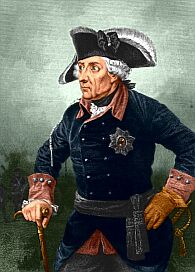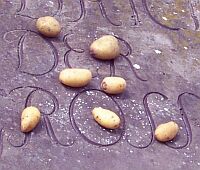|
 Frederick the Great, King of Prussia
N 52° 24.245 E 013° 02.383
33U E 366647 N 5807790
The simple grave of the philosopher amongst kings
Waymark Code: WM2858
Location: Brandenburg, Germany
Date Posted: 09/20/2007
Views: 242
|
As a philosopher I have lived and as a philosopher I want to be buried - without pomp and without ceremony. I want neither be exhumed nor embalmed. Also, do not expose my body to the nosy public. Three days after I died, at midnight, carry me out of the castle, using only one lantern. Nobody is supposed to follow. Burry me quietly at the terraces of Sanssouci; to the right of the castle.
Last will of Frederick II, King of Prussia
(1712-1786) |
 |
|
This is the simple grave of a king who was called "the great", a title he shared with Alexander, Peter and few others. Frederick II of Prussia fought three wars and turned his country into the most powerful German state - at the same time he loved to play flute and discuss philosophy. An extensive biography can be found at wikipedia.
It was his wish to be buried next to his beloved castle Sanssouci, but it took a long time for his wish to come true. First, his nephew and successor Friedrich Wilhelm II had him buried in the Potsdam Garrison Church. At the end of World War II, Friedrich's remains were moved to Marburg and in 1952, he was put to rest at Burg Hohenzollern. It wasn't until after German reunification that he found his final resting place. In 1991, 205 years after his death, he was finally buried at the terraces of Sanssouci, next to his beloved dogs. Still, it was not according to his wishes. He wanted a simple burial without pomp and ceremony, but the newly united German state used his fame to orchestrate a huge state burial - something the "Old Fritz" would have never wanted.
|
 |
But at least, his request for a simple site was respected. No statue, just a simple granite plaque with his name on it.
Many visitors honor Frederick the Great for what is probably his greatest accomplishment: Legend has it that he was the first head of state in Europe to introduce potatoes as a main crop, hence avoiding an imminent famin. |
Description:
One of the most famous German monarchs

Date of birth: 01/24/1712

Date of death: 08/17/1786

Area of notoriety: Politics

Marker Type: Plaque

Setting: Outdoor

Visiting Hours/Restrictions: open all day

Fee required?: No

Web site: [Web Link]

|
Visit Instructions:
To post a visit log for waymarks in this category, you must have personally visited the waymark location. When logging your visit, please provide a note describing your visit experience, along with any additional information about the waymark or the surrounding area that you think others may find interesting.
We especially encourage you to include any pictures that you took during your visit to the waymark. However, only respectful photographs are allowed. Logs which include photographs representing any form of disrespectful behavior (including those showing personal items placed on or near the grave location) will be subject to deletion.
|